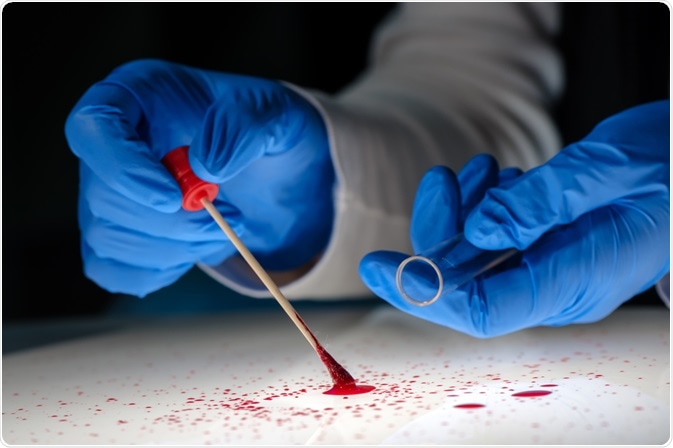What is Raman scattering and what is its use in forensic science?
The method of Raman scattering is an optical process that relies upon the inelastic scattering of photons that occurs when interacting with a target matter/sample, producing a scattering of light lower (or higher) in energy, due to the vibrational modes of the chemical bonds in the sample.

Image Credit: Igorstevanovic/Shutterstock.com
Raman spectroscopy can provide information about the chemical structure and identity of compounds.
The field of forensic science has greatly benefited from the use of this method due to its advantages over other scientific techniques.
For example, Raman spectroscopy does not require careful sample preparation that is necessary with alternative methods, such as infrared spectroscopy. Also, it can analyze a wider range of samples.
Aqueous solutions can also be analyzed with this method, something which is a limitation of many similar techniques. Raman spectroscopy also generally produces a cleaner spectrum than other similar techniques do, and it has greater versatility.
Moreover, Raman spectroscopy is a non-destructive technique, which is also another advantage due to the need of analyzing material that can be regarded as evidence in a court case. Ιt is always preferable to preserve evidence in their original state.
Since the data produced by forensic analysis is often used as evidence in court, it is of paramount importance that it is highly accurate and reliable, for this reason, Raman scattering has found itself being used in many areas of forensic science for its robustness.
Below, we discuss the numerous applications of Raman scattering in forensic science.
Blood and body fluids
Blood and body fluid samples are highly important to forensic science. They can place a person at a crime scene and even be used as evidence of a suspect’s guilt.
Studies have shown that Raman scattering from human blood can indicate essential factors such as the identity of the donor, as well as its age and dilution.
Research has also demonstrated that Raman scattering is more powerful than alternative luminescence methods that have lower sensitivities.
Other bodily fluids, such as tears, saliva, semen, sweat, urine, and vaginal secretion can also be analyzed with Raman scattering.
Importantly, the Raman method is non-destructive, meaning that samples can be retained for future testing. This is vital in forensic studies because often only a small trace of the sample is left at the scene.
Fibers and physical evidence
Surface-enhanced Raman scattering (SERS) and standard Raman is heavily relied on by forensics labs to test a myriad of physical evidence that is collected from crime scenes.
For example, it can be used to analyze dyes, paints, fibers, textiles, and even lipsticks and smears of shoe polish.
Raman and SERS can match the samples with known samples, determining their identity, they can also provide key information about small trace evidence, such as the color of a paint chip, the origin of a textile and how it was made. It can even be utilized to compare hair samples, helping identify suspects.
Gunshot residue
Gunshot residue can be a key piece of evidence in criminal cases.
While scanning electron microscopes with energy dispersive spectroscopy (SEM/EDS) is most commonly used to analyze gunshot residue, Raman scattering can help determine minute traces from almost any type of surface, without a need of altering the evidence in any way
Illicit drugs
Raman scattering and SERS have long been used to analyze illicit drugs.
While infrared spectroscopy has traditionally been the most common method for detecting and identifying illicit drugs, Raman techniques have gained popularity due to their non-destructive nature and short turnaround time.
Fraudulent documents
Finally, Raman scattering can also be used to help detect fraud. Documents can be amended, and signatures forged using sophisticated techniques that make fraud difficult to detect.
However, Raman spectroscopy has a high sensitivity to minimal changes in chemical structure, and therefore, it can easily flag differences in inks used on a document to highlight where changes have been made to the original piece.
Sources:
- Boyd, S., Bertino, M. and Seashols, S. (2011). Raman spectroscopy of blood samples for forensic applications. Forensic Science International, 208(1-3), pp.124-128. https://www.sciencedirect.com/science/article/pii/S037907381000513X
- Muehlethaler, C., Leona, M. and Lombardi, J. (2015). Review of Surface-Enhanced Raman Scattering Applications in Forensic Science. Analytical Chemistry, 88(1), pp.152-169. https://pubs.acs.org/doi/abs/10.1021/acs.analchem.5b04131
- Suzuki, E. and Gresham, W. (1986). Forensic Science Applications of Diffuse Reflectance Infrared Fourier Transform Spectroscopy (DRIFTS): I. Principles, Sampling Methods, and Advantages. Journal of Forensic Sciences, 31(3), p.11102J. https://www.ncbi.nlm.nih.gov/pubmed/30064966
Further Reading
Last Updated: Feb 3, 2021